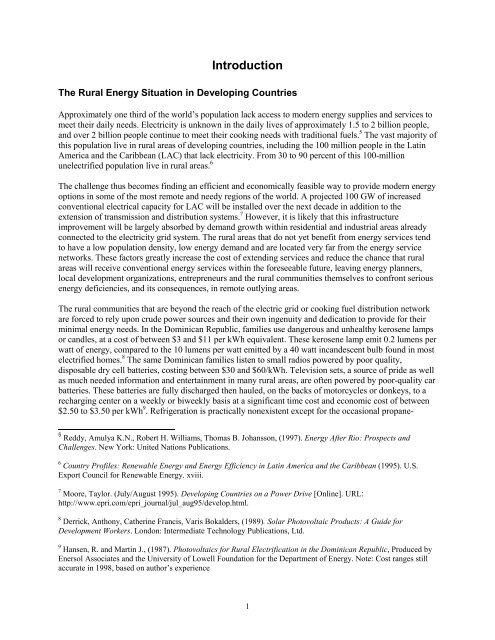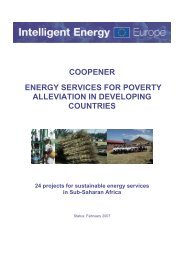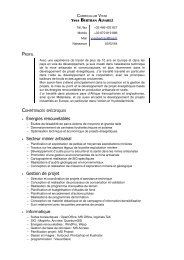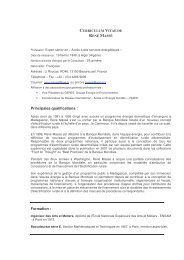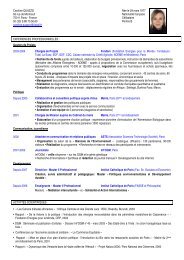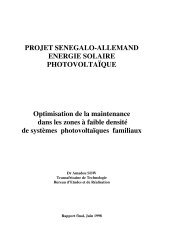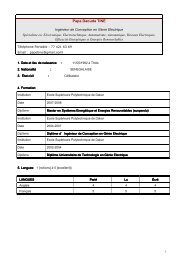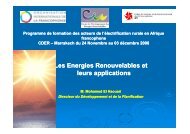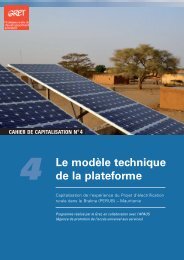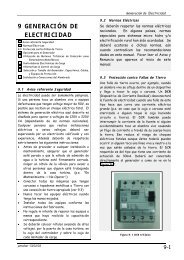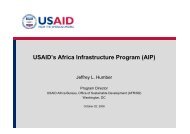Solar-Based Rural Electrification and Micro-Enterprise ... - NREL
Solar-Based Rural Electrification and Micro-Enterprise ... - NREL
Solar-Based Rural Electrification and Micro-Enterprise ... - NREL
Create successful ePaper yourself
Turn your PDF publications into a flip-book with our unique Google optimized e-Paper software.
IntroductionThe <strong>Rural</strong> Energy Situation in Developing CountriesApproximately one third of the world’s population lack access to modern energy supplies <strong>and</strong> services tomeet their daily needs. Electricity is unknown in the daily lives of approximately 1.5 to 2 billion people,<strong>and</strong> over 2 billion people continue to meet their cooking needs with traditional fuels. 5 The vast majority ofthis population live in rural areas of developing countries, including the 100 million people in the LatinAmerica <strong>and</strong> the Caribbean (LAC) that lack electricity. From 30 to 90 percent of this 100-millionunelectrified population live in rural areas. 6The challenge thus becomes finding an efficient <strong>and</strong> economically feasible way to provide modern energyoptions in some of the most remote <strong>and</strong> needy regions of the world. A projected 100 GW of increasedconventional electrical capacity for LAC will be installed over the next decade in addition to theextension of transmission <strong>and</strong> distribution systems. 7 However, it is likely that this infrastructureimprovement will be largely absorbed by dem<strong>and</strong> growth within residential <strong>and</strong> industrial areas alreadyconnected to the electricity grid system. The rural areas that do not yet benefit from energy services tendto have a low population density, low energy dem<strong>and</strong> <strong>and</strong> are located very far from the energy servicenetworks. These factors greatly increase the cost of extending services <strong>and</strong> reduce the chance that ruralareas will receive conventional energy services within the foreseeable future, leaving energy planners,local development organizations, entrepreneurs <strong>and</strong> the rural communities themselves to confront seriousenergy deficiencies, <strong>and</strong> its consequences, in remote outlying areas.The rural communities that are beyond the reach of the electric grid or cooking fuel distribution networkare forced to rely upon crude power sources <strong>and</strong> their own ingenuity <strong>and</strong> dedication to provide for theirminimal energy needs. In the Dominican Republic, families use dangerous <strong>and</strong> unhealthy kerosene lampsor c<strong>and</strong>les, at a cost of between $3 <strong>and</strong> $11 per kWh equivalent. These kerosene lamp emit 0.2 lumens perwatt of energy, compared to the 10 lumens per watt emitted by a 40 watt inc<strong>and</strong>escent bulb found in mostelectrified homes. 8 The same Dominican families listen to small radios powered by poor quality,disposable dry cell batteries, costing between $30 <strong>and</strong> $60/kWh. Television sets, a source of pride as wellas much needed information <strong>and</strong> entertainment in many rural areas, are often powered by poor-quality carbatteries. These batteries are fully discharged then hauled, on the backs of motorcycles or donkeys, to arecharging center on a weekly or biweekly basis at a significant time cost <strong>and</strong> economic cost of between$2.50 to $3.50 per kWh 9 . Refrigeration is practically nonexistent except for the occasional propane-5 Reddy, Amulya K.N., Robert H. Williams, Thomas B. Johansson, (1997). Energy After Rio: Prospects <strong>and</strong>Challenges. New York: United Nations Publications.6 Country Profiles: Renewable Energy <strong>and</strong> Energy Efficiency in Latin America <strong>and</strong> the Caribbean (1995). U.S.Export Council for Renewable Energy. xviii.7 Moore, Taylor. (July/August 1995). Developing Countries on a Power Drive [Online]. URL:http://www.epri.com/epri_journal/jul_aug95/develop.html.8 Derrick, Anthony, Catherine Francis, Varis Bokalders, (1989). <strong>Solar</strong> Photovoltaic Products: A Guide forDevelopment Workers. London: Intermediate Technology Publications, Ltd.9 Hansen, R. <strong>and</strong> Martin J., (1987). Photovoltaics for <strong>Rural</strong> <strong>Electrification</strong> in the Dominican Republic, Produced byEnersol Associates <strong>and</strong> the University of Lowell Foundation for the Department of Energy. Note: Cost ranges stillaccurate in 1998, based on author’s experience1


